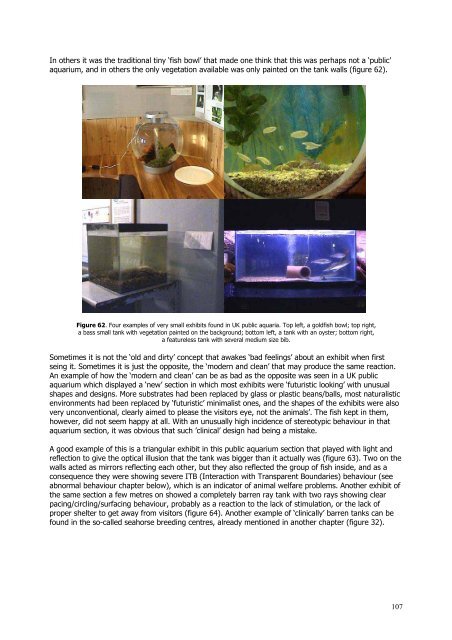Aquatic Zoos - Captive Animals Protection Society
Aquatic Zoos - Captive Animals Protection Society
Aquatic Zoos - Captive Animals Protection Society
You also want an ePaper? Increase the reach of your titles
YUMPU automatically turns print PDFs into web optimized ePapers that Google loves.
In others it was the traditional tiny ‘fish bowl’ that made one think that this was perhaps not a ‘public’<br />
aquarium, and in others the only vegetation available was only painted on the tank walls (figure 62).<br />
Figure 62. Four examples of very small exhibits found in UK public aquaria. Top left, a goldfish bowl; top right,<br />
a bass small tank with vegetation painted on the background; bottom left, a tank with an oyster; bottom right,<br />
a featureless tank with several medium size bib.<br />
Sometimes it is not the ‘old and dirty’ concept that awakes ‘bad feelings’ about an exhibit when first<br />
seing it. Sometimes it is just the opposite, the ‘modern and clean’ that may produce the same reaction.<br />
An example of how the ‘modern and clean’ can be as bad as the opposite was seen in a UK public<br />
aquarium which displayed a ‘new’ section in which most exhibits were ‘futuristic looking’ with unusual<br />
shapes and designs. More substrates had been replaced by glass or plastic beans/balls, most naturalistic<br />
environments had been replaced by ‘futuristic’ minimalist ones, and the shapes of the exhibits were also<br />
very unconventional, clearly aimed to please the visitors eye, not the animals’. The fish kept in them,<br />
however, did not seem happy at all. With an unusually high incidence of stereotypic behaviour in that<br />
aquarium section, it was obvious that such ’clinical’ design had being a mistake.<br />
A good example of this is a triangular exhibit in this public aquarium section that played with light and<br />
reflection to give the optical illusion that the tank was bigger than it actually was (figure 63). Two on the<br />
walls acted as mirrors reflecting each other, but they also reflected the group of fish inside, and as a<br />
consequence they were showing severe ITB (Interaction with Transparent Boundaries) behaviour (see<br />
abnormal behaviour chapter below), which is an indicator of animal welfare problems. Another exhibit of<br />
the same section a few metres on showed a completely barren ray tank with two rays showing clear<br />
pacing/circling/surfacing behaviour, probably as a reaction to the lack of stimulation, or the lack of<br />
proper shelter to get away from visitors (figure 64). Another example of ‘clinically’ barren tanks can be<br />
found in the so-called seahorse breeding centres, already mentioned in another chapter (figure 32).<br />
107



